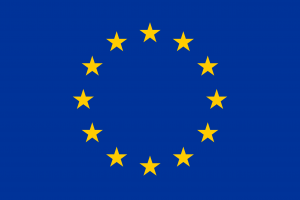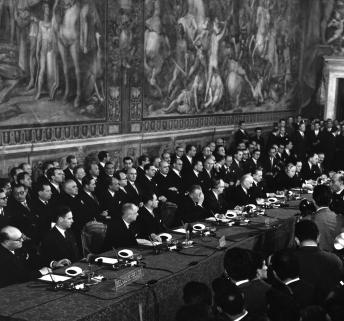Key milestones in the history of the European Union
After the horrors that took place in Europe during the two World Wars of the 20th century, the desire emerged to create an institution that would unite the nations of Europe, foster economic cooperation, and prevent the recurrence of such conflicts.
What began as a purely economic organisation has evolved into a union that spans many different policy areas – from climate, environment and health to foreign affairs and security, justice and migration. As a result, the European Union (EU) has delivered more than half a century of peace, stability and prosperity for its citizens.
EU timeline
SCHUMAN DECLARATION
The proposal by then French Foreign Minister Robert Schuman to create a European Coal and Steel Community (ECSC) is considered the starting point of the European integration process. Following the devastation of the two World Wars, Schuman declared that “The pooling of coal and steel production will change the destiny of those regions which for so long have been devoted to the manufacture of weapons, of which they themselves have been the first victims.” He concluded that “World peace cannot be safeguarded without the making of creative efforts proportionate to the dangers which threaten it,” and that “Europe will not be made all at once, or according to a single plan: it will be built through concrete achievements which first create a de facto solidarity.”
EUROPEAN COAL AND STEEL COMMUNITY (ECSC)
The signing of the Treaty of Paris established the European Coal and Steel Community (ECSC) between six countries: West Germany, France, Italy, Belgium, the Netherlands and Luxembourg. It was the first European supranational community with concrete competences in strategic sectors. Moreover, it laid the foundations for future forms of political and economic integration, as envisioned by Robert Schuman.
EUROPEAN ECONOMIC COMMUNITY AND EURATOM
Through the Treaties of Rome, the European Economic Community (EEC) and the European Atomic Energy Community (EURATOM) were established. The main objective of the EEC was to lay the foundations for a common market and an economic union, while EURATOM aimed to foster cooperation in the field of nuclear energy for peaceful purposes.
LAUNCH OF THE COMMON AGRICULTURAL POLICY
The Common Agricultural Policy (CAP) was launched with the aim of ensuring a stable supply of affordable food, supporting farmers, and stabilising agricultural markets. It was one of the first fully funded common policies under the European budget. Its impact has been crucial for rural development and food security across Europe.
FIRST ENLARGEMENT
Denmark, Ireland and the United Kingdom joined the Community, expanding it to nine Member States. This first enlargement demonstrated the appeal of the European project and marked an important step towards a more diverse and plural Europe. Several further enlargements would follow in the years to come.
FIRST DIRECT ELECTIONS TO THE EUROPEAN PARLIAMENT
Citizens voted directly for their representatives in the European Parliament, strengthening the democratic dimension of the European project. Until then, Members of the European Parliament (MEPs) had been appointed by national parliaments, as is the case in other regional assemblies. This change represented a key step forward in the institutional development and democratic legitimacy of the EU.
SIGNING OF THE SCHENGEN AGREEMENT
Five countries of the European Community signed an agreement to gradually abolish internal border controls. This pact laid the foundation for the Schengen Area, which today allows the free movement of people across 29 European countries. The removal of border checks between EU countries enables citizens to move freely, including the right to live or work in another European country. Each EU country must treat EU citizens in the same way as its own nationals in matters of employment, social security and healthcare.
LAUNCH OF THE ERASMUS PROGRAMME
The European Commission launched Erasmus, an academic mobility programme for university students within Europe. Since 2014, the Erasmus+ programme has also been open to third countries, including Panama. To this day, millions of young people have benefited from exchange experiences that promote learning, active citizenship and intercultural understanding.
FALL OF THE BERLIN WALL
The fall of the Berlin Wall marked the end of Europe's division after the Cold War. It was a symbolic event that paved the way for German reunification and future enlargements of the European Union towards the East. This was a pivotal moment in contemporary history that directly influenced the EU’s enlargement and integration policies.
SINGLE MARKET AND EUROPEAN UNION
The Maastricht Treaty was signed, officially establishing the European Union and introducing new competences in foreign policy, justice and economic affairs. It also created EU citizenship and the Single Market – the EU’s main economic engine – which allows most goods, services, people and capital to move freely. In this way, what began as an economic union evolved into an organisation encompassing a wide range of political areas, a transformation reflected in the change of name from the European Economic Community to the European Union.
PROCLAMATION OF THE CHARTER OF FUNDAMENTAL RIGHTS OF THE EU
The Charter of Fundamental Rights of the European Union was proclaimed in Nice, bringing together in a single text the civil, political, economic and social rights of European citizens. Among the human rights protected by the Charter are the right not to be discriminated against on the basis of sex, racial or ethnic origin, religion or belief, disability, age or sexual orientation; the right to the protection of personal data; and the right of access to justice. Since the entry into force of the Treaty of Lisbon in 2009, the Charter has been legally binding, consolidating respect for human rights as a core principle of the European project.
INTRODUCTION OF EURO BANKNOTES AND COINS
The euro entered into physical circulation in 12 Member States, becoming one of the most visible symbols of European integration. Today, it is the second most widely used currency in the world and the official currency of 20 countries. A single currency brings many advantages: cross-border trade becomes easier for businesses, economic performance improves, and consumers enjoy greater choice and more opportunities. In addition to the use of the euro, the Economic and Monetary Union also involves the coordination of economic and budgetary policies.
LARGEST ENLARGEMENT IN EU HISTORY
Ten countries joined the European Union in its largest enlargement to date: Cyprus, Slovakia, Slovenia, Estonia, Hungary, Latvia, Lithuania, Malta, Poland and the Czech Republic. This expansion represented a historic step towards the reunification of the continent after the Cold War and brought the total number of Member States to 24. Three years later, Bulgaria and Romania joined, followed by Croatia in 2013 as the most recent Member State. In 2020, the United Kingdom left the Union in a process known as Brexit.
CREATION OF THE EUROPEAN EXTERNAL ACTION SERVICE (EEAS)
The European External Action Service (EEAS) came into operation as the diplomatic service of the European Union. Its objective is to coordinate the EU’s external action and strengthen its presence and influence in the world, under the leadership of the High Representative for Foreign Affairs and Security Policy. The EEAS carries out its mission through a global network of more than 140 EU Delegations around the world.
THE EUROPEAN UNION IS AWARDED THE NOBEL PEACE PRIZE
The European Union was awarded the Nobel Peace Prize for its contribution over more than six decades to the advancement of peace, reconciliation, democracy and human rights in Europe. The award is currently on display at the House of European History, a free museum located in Brussels, Belgium.
ADOPTION OF THE NEXTGENERATIONEU INSTRUMENT
EU leaders agreed on an unprecedented recovery fund to address the crisis caused by the COVID-19 pandemic: the NextGenerationEU instrument was approved, with the aim of raising up to 800 billion EUR through the issuance of joint bonds to respond to the crisis, support economic recovery, and build a greener, more digital and more resilient future.
















